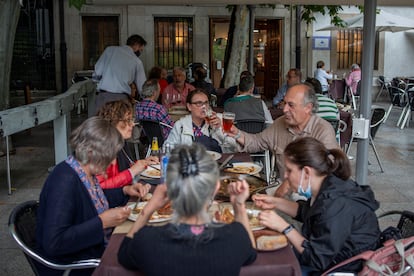Delta coronavirus variant now dominant in at least four Spanish regions
According to the latest Health Ministry report, the more contagious strain accounts for 11% of cases, but experts warn that the real figure is much higher


The delta strain of the coronavirus is spreading rapidly across Spain. The variant – first discovered in India – is advancing at different speeds across the country, but is now dominant in at least four regions: Madrid, Catalonia, Valencia and Navarre. According to the latest Health Ministry report on variants from June 14, the strain accounts for 11% of coronavirus samples analyzed. But experts believe that the real spread of the strain is much greater and data from the regions collated by EL PAÍS indicate that it is rising at breakneck speed.
This alarming jump comes amid a surge in coronavirus infections among young people, with the 14-day cumulative number of cases per 100,000 inhabitants for the 20-29 age group rising to 814. Based on the information from 11 of Spain’s 17 regions – which are in charge of controlling the pandemic in their territories as well as the Covid-19 vaccination drive – the average prevalence of the delta strain is not 11% but 32%.
The delta variant is up to 60% more contagious than the alpha strain, which was first detected in the United Kingdom and is currently dominant in Europe. It is also more resistant to Covid-19 vaccines if only one shot has been administered. A study from authorities in the United Kingdom – where the strain is already dominant – indicates that the Pfizer-BioNTech and Oxford-AstraZeneca vaccines are only 35% effective against the delta strain if one dose has been given, compared to 50% for the alpha. The vaccines, however, are equally effective against both strains if a person is fully vaccinated, and provide a high level of protection against the risk of developing a serious case of Covid-19, with both one and two shots.
The point that’s worrying is that young people could spread the virus to the elderly, even if they are vaccinatedTomàs Pumarola, head of Microbiology at the Vall d’Hebron Hospital in Barcelona
But experts warn that not all at-risk groups have been fully vaccinated. Some 40% of the 60-69 population in Spain have still not received their second dose, while 25% of the 40-49 age group have not had the first. What’s more, vaccines do not completely eliminate the risk of infection. “The point that’s worrying is that young people could spread the virus to the elderly, even if they are vaccinated,” says Tomàs Pumarola, the head of Microbiology at the Vall d’Hebron Hospital in Barcelona. “The vaccine protection against hospitalization from the delta is high, but the immune system of an 80-year-old does not respond the same way as a person who is 60.”
Pumarola says that the delta variant is already dominant in Catalonia. According to the regional health department, 60% of new cases are caused by this more contagious strain. Catalonia has the highest incidence rate in Spain – the 14-day number of cases per 100,000 inhabitants is 557 and 2,000 for the 20-29 age group.
The delta strain is also dominant in Madrid, accounting for 44.3% of cases, compared to 41.6% for the alpha. In Valencia, regional premier Ximo Puig said the prevalence of the variant is close to 50%. And in Navarre, the new strain is responsible for around 80% of infections. The Canary Islands and Balearic Islands have not updated their figures, but according to last week’s data, the delta variant accounted for 10% and 25% of new cases, respectively.
Carmen Ezpeleta, the head of Microbiology at the Navarre Hospital Complex, says that of the 100 cases that are analyzed every day, between 92% and 95% correspond to the delta strain, although the data changes on a daily basis. “We had a slow rise [of the delta strain] before the outbreak in Salou [when 700 students in Navarre contracted the virus after an end-of-term vacation in Salou, in Catalonia]. But after the outbreak, it was explosive,” she says.
Patricia Muñoz, the head of Microbiology and Infectious Diseases at Gregorio Marañón Hospital in Madrid, says the rise of the delta strain has been “totally explosive.” “It began relatively soon and we could already see that it was spreading in the region very effectively,” she explains. “In my hospital, now, 60% of cases that we analyze are from the delta variant. It could vary depending on the area, but in Madrid, it is already spreading in the community.”
The spread of the delta variant varies from region to region. In the Basque Country, for example, authorities put the prevalence of the strain at between 33% and 35% of all cases detected, although the alpha variant continues to be dominant. In Aragón, the figure is also around 35%, but this is based on a small sample size of just 178 cases. Meanwhile, in Extremadura and Galicia, the prevalence is much lower, with the delta accounting for 11.11% and 6.4% of infections, respectively.
Authorities in La Rioja say they have not detected the presence of the delta strain, and in Castilla-La Mancha, the presence is said to be minimum, although an exact percentage was not specified. The regional government of Andalusia says that “a rise” in the delta variant has been detected among new contagions, but the region does not have exact figures on the prevalence of the strain. Murcia, Cantabria, Asturias and Castilla y León did not provide specific information on the presence of the strain in their respective regions.
Sequencing the virus
There is no uniform protocol among the regions on how to measure the spread of variants in real-time. The Health Ministry, for example, uses random samples, although these are very limited and the results are published with weeks of delay. The latest report, for instance, analyzed the prevalence of variants between June 14 and 20 – before the surge in cases following outbreaks linked to end-of-term student vacations and San Juan fiestas.
“The delta variant changes every day and the data from the Health Ministry are released with major delays,” says Ezpeleta. “Every Friday, you have to send them the data from the week before, but these figures do not reflect the current reality.”
According to the Navarre health department, all positive cases in the region are analyzed – a PCR test is first carried out and then the genome of the virus is sequenced to confirm the variant. This task is possible given the small size of the region’s population, explains Jesús Castilla, the head of the group that monitors infectious diseases at the Navarre Public Health and Work Institute. “In Navarre, for our size, we have advantages, it is all more manageable. Only one laboratory does the tests and putting together the information is much easier,” he says.
At the Gregorio Marañón Hospital in Madrid, there is mass testing of positive cases, which are given a PCR that can identify variants. The virus is then sequenced to verify the strain and to see whether it has the same genome as other cases, which would indicate they belong to the same outbreak. Meanwhile, at Vall d’Hebron Hospital in Barcelona, the priority is to sequence a large number of samples to get an accurate picture of the spread of the variants.
The methods may be different, but the diagnosis is the same. “When the alpha entered a home, 60% of people were infected. The delta infects 100%. And that, combined with the reopening of activities [such as nightlife venues], has favored the rise in cases. The rest of the variants are laying low and the alpha is plummeting. The delta will be dominant until another, stronger one comes to replaces it,” concludes Pumarola.
The experts agree that the delta variant is spreading more quickly than the alpha did when it first entered Spain. According to the European Center for Disease Prevention and Control, the delta strain will account for 90% of coronavirus infections in Europe by the end of August. Juan Carlos Galán, a spokesperson of the Spanish Society of Infectious Diseases and Clinical Microbiology, says that the variant “is not the cause nor the trigger of the current epidemic situation, but rather an additive, another factor.” He warns: “The problem that we could have is that, as these new variants emerge, which are descendants from the previous ones, they will have a slightly better ability to resist the neutralizing antibodies [of Covid-19 vaccines]. Now there is a race between vaccination and the virus to resist it. Each variant is another step in the capacity to evade antibodies and we don’t know what step is the cataclysm that will lead us to vaccination failure.”
With information from Isabel Valdés, Mikel Ormazabal, Lucía Bohórquez, Javier Martín-Arroyo, Ferran Bono, Silvia R. Pontevedra and Juan Navarro.
English version by Melissa Kitson.
Tu suscripción se está usando en otro dispositivo
¿Quieres añadir otro usuario a tu suscripción?
Si continúas leyendo en este dispositivo, no se podrá leer en el otro.
FlechaTu suscripción se está usando en otro dispositivo y solo puedes acceder a EL PAÍS desde un dispositivo a la vez.
Si quieres compartir tu cuenta, cambia tu suscripción a la modalidad Premium, así podrás añadir otro usuario. Cada uno accederá con su propia cuenta de email, lo que os permitirá personalizar vuestra experiencia en EL PAÍS.
¿Tienes una suscripción de empresa? Accede aquí para contratar más cuentas.
En el caso de no saber quién está usando tu cuenta, te recomendamos cambiar tu contraseña aquí.
Si decides continuar compartiendo tu cuenta, este mensaje se mostrará en tu dispositivo y en el de la otra persona que está usando tu cuenta de forma indefinida, afectando a tu experiencia de lectura. Puedes consultar aquí los términos y condiciones de la suscripción digital.
More information
Últimas noticias
Most viewed
- Reinhard Genzel, Nobel laureate in physics: ‘One-minute videos will never give you the truth’
- Oona Chaplin: ‘I told James Cameron that I was living in a treehouse and starting a permaculture project with a friend’
- Pablo Escobar’s hippos: A serious environmental problem, 40 years on
- Why we lost the habit of sleeping in two segments and how that changed our sense of time
- Chevy Chase, the beloved comedian who was a monster off camera: ‘Not everyone hated him, just the people who’ve worked with him’










































